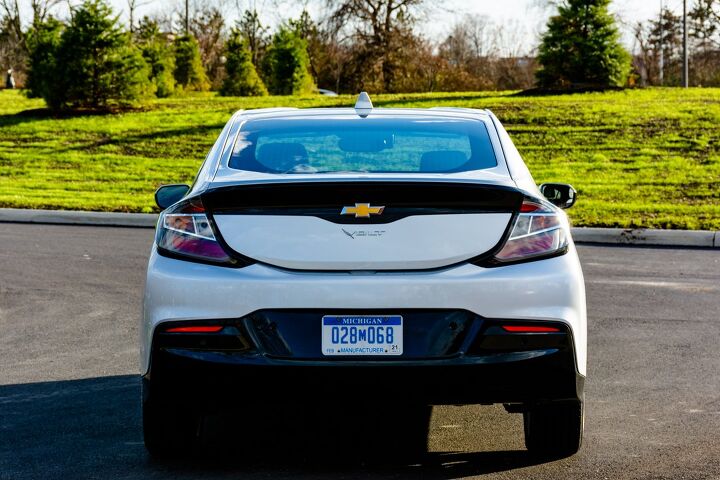Chevrolet Volt Postmortem: How Not to Market a Car With a Gasoline Engine

February 15th was a sad day, even for those who hate cars. On that day, General Motors’ Detroit-Hamtramck assembly plant produced the last Chevrolet Volt — a green car born at the dawn of a new era that didn’t take off exactly as envisioned.
In the truck-loving land of (relatively) cheap gasoline, electric vehicles are only just now eating up more than 1 percent of the market, thanks mainly to the Tesla Model 3 and what ownership of said vehicle says about your lifestyle and viewpoints. Plug-in hybrids are struggling, however, and the most famous of them all is now dead. A victim of falling sales, though your author would be curious to learn the model’s margin.
Despite offering the most practical combination of conventional gas-powered driving and electric ability, many claim the Volt’s failure was one of marketing, not engineering.
First off, while electric vehicles were all the rage in the waning days of Obama’s first term, the novelty didn’t rub off on everyone. Minus the limited (and pricey) Tesla Roadster, electric vehicle ownership, be it a Nissan Leaf or Ford Focus Electric, meant renting a car for road trips out of town. How does 76 miles of driving distance sound, under ideal circumstances?
Suffice it to say that battery capacity was limited, range anxiety was widespread, and the majority of the driving public wasn’t even close to making the switch. Which is why GM’s preferred descriptor for the Volt — a “range-extended electric vehicle” — may have been a poor choice when dealing with a fearful public and a fledgling segment. Even recent studies show that modern drivers in first-world countries remain confused by terms like “electrified.”
Many don’t know that a plug-in hybrid actually has an engine that powers the vehicle most of the time. To this not-insignificant swath of the population, the mere presence of the words “plug” and “electric” means one thing — that the vehicle is, in fact, fully electric, and might leave them stranded on the side of the road in a remote corner of the countryside where those unsolved murders happened four years ago.
Speaking to Automotive News, Michael Harley, managing editor of Autotrader and Kelley Blue Book, said, “Overall, marketing and advertising for the Volt needed to focus on education as much as it did traditional selling. A lack of a proper customer perception played a very large role in the demise of the Chevrolet Volt.”
Unlike early PHEVs, the Volt offered a healthy electric range designed to get the average commuter to work and back without the need to fire up the onboard inline-four generator. The second-generation model improved upon its predecessor’s range. Considering its price and size, the Volt remains the best bet for a driver who wants to travel most of his or her miles electrically, while maintaining the capacity for go-anywhere road trips. It’s too bad it’s gone.
The general consensus is that GM played up the Volt’s electric side too prominently in its early days, leading to assumptions about its ability — something the automaker admitted in the recent past. Other factors exist, sure. For a Chevrolet hatchback, the Volt started off pricey, though subsequent MSRP haircuts brought its starting price to a more palatable level. Content is another thing. The Volt only gained a power driver’s seat for its final, truncated 2019 model year. Then there’s the basic worry that a complex powertrain might go haywire, boosting long-term costs.
Still, it cannot be argued that the public was totally on the same page as GM’s marketing folks.
“The problem with PHEVs is it’s a mouthful, and people still aren’t sure what a PHEV is,” said Dan Edmunds, director of vehicle testing at Edmunds. “Nobody’s been able to figure out how to talk about a plug-in hybrid, and I think that’s because we started on the wrong foot.”
Everything GM did to cover up the fact that the Volt was, at its core, a hybrid, worked against the model’s sales. The onboard generator wasn’t a 1.4-liter (later 1.5-liter) four-cylinder — it was a “range-extender.” While an electric motor did propel the Volt all of the time, the backup generator received short thrift. The release of a fully electric Chevrolet with a similar name for 2017 didn’t help alleviate confusion. Quite the opposite.
Educating the public on new things can be difficult, but effective communication is always possible. There’s also the choice of not mentioning electricity at all.
For its upcoming Aviator and Corsair plug-in hybrids, Lincoln is choosing to avoid mentioning the word “hybrid” altogether. As Automotive News reports, the two crossovers don “Grand Touring” labelling, playing up the models’ range-topping opulence and additional power (in the Aviator, at least — no power specs exist for the Corsair) instead of its electrified alter ego.
We’re trying to be really transparent for our customers,” said Mark Grueber, Ford’s consumer marketing manager. “We’re focused on delivering the attributes they care about and marketing it in a way that speaks to their priorities instead of making it more like a science project.”
[Images: © 2019 Chris Tonn/TTAC, General Motors]

More by Steph Willems
Latest Car Reviews
Read moreLatest Product Reviews
Read moreRecent Comments
- Mike-NB2 This is a mostly uninformed vote, but I'll go with the Mazda 3 too.I haven't driven a new Civic, so I can't say anything about it, but two weeks ago I had a 2023 Corolla as a rental. While I can understand why so many people buy these, I was surprised at how bad the CVT is. Many rentals I've driven have a CVT and while I know it has one and can tell, they aren't usually too bad. I'd never own a car with a CVT, but I can live with one as a rental. But the Corolla's CVT was terrible. It was like it screamed "CVT!" the whole time. On the highway with cruise control on, I could feel it adjusting to track the set speed. Passing on the highway (two-lane) was risky. The engine isn't under-powered, but the CVT makes it seem that way.A minor complaint is about the steering. It's waaaay over-assisted. At low speeds, it's like a 70s LTD with one-finger effort. Maybe that's deliberate though, given the Corolla's demographic.
- Mike-NB2 2019 Ranger - 30,000 miles / 50,000 km. Nothing but oil changes. Original tires are being replaced a week from Wednesday. (Not all that mileage is on the original A/S tires. I put dedicated winter rims/tires on it every winter.)2024 - Golf R - 1700 miles / 2800 km. Not really broken in yet. Nothing but gas in the tank.
- SaulTigh I've got a 2014 F150 with 87K on the clock and have spent exactly $4,180.77 in maintenance and repairs in that time. That's pretty hard to beat.Hard to say on my 2019 Mercedes, because I prepaid for three years of service (B,A,B) and am getting the last of those at the end of the month. Did just drop $1,700 on new Michelins for it at Tire Rack. Tires for the F150 late last year were under $700, so I'd say the Benz is roughly 2 to 3 times as pricy for anything over the Ford.I have the F150 serviced at a large independent shop, the Benz at the dealership.
- Bike Rather have a union negotiating my pay rises with inflation at the moment.
- Bike Poor Redapple won't be sitting down for a while after opening that can of Whiparse





































Comments
Join the conversation
The Volt does not rely on the ICE "most of the time." The misinformation within this article highlights the general lack of understanding that most people have with the variety of electric options on the market. It can be confusing, and sometimes it takes people a while for the technology to become clear. My aunt and uncle joined me on a 120 mile road trip in my Model X. Though they knew it was a Tesla, they asked when we were going to "stop for gas." Then after I explained that we weren't, the questions became all about how we were going to charge the car and what would happen if we got stuck in traffic. They were amazed with the fact that we could do the entire trip without the need to stop, visit three wineries throughout the day, have plenty of reserve in the "tank" and I would "refuel" the car in my garage after arriving while we ate dinner. The reality is, full EVs are much easier to understand than those with hybrid drivetrains and range extender engines.
We bought a 2017 Volt when it came off lease. What a great car! Cost us $18,000 to buy. We put gas in it a couple of times a year. GM blew it with this car as they have done with others. No buyer education. This should have been the bridge car between pure ICE vehicles and pure battery vehicles. No range anxiety at all. And ours still gets 44 mpg running the gas "generator" to power the electric motor. We love it and wish a new model would return to market.